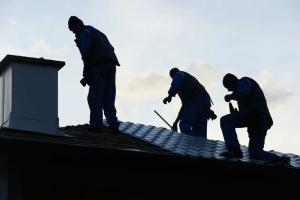Emergency Roof Tarping Provides Immediate Protection Following Structural Damage
Jules Albert III, owner of Jaymar Roofing in Slidell, Louisiana, explains "Temporary tarping is often the first line of defense while property owners coordinate long-term repairs. It serves as a stabilizing measure, allowing for damage assessments, insurance inspections, and eventual reconstruction without the compounding risks associated with ongoing exposure to the elements."
The Purpose of Emergency Tarping
Roof tarping is a temporary solution designed to shield a damaged roof from rain, debris, and further deterioration. The process involves covering compromised sections of a roof with waterproof material—typically polyethylene or reinforced tarp—secured in place with nails, wood strips, or weighted systems depending on the structure’s condition.
The primary objective is not to provide a permanent fix, but to prevent the situation from worsening. Water entering through a roof breach can saturate insulation, short-circuit electrical systems, damage ceilings, and lead to microbial growth. These secondary effects often carry higher restoration costs than the initial roof damage itself.
When Tarping Becomes Necessary
Emergency roof tarping becomes necessary when shingles are blown off, tree limbs puncture the roof, or flashing and sealants fail during severe weather. In regions like South Louisiana, seasonal storms and hurricanes make tarping services a frequent requirement during active weather months.
In commercial settings, tarping may be required after fire department responses or mechanical failures where water lines or sprinkler systems have compromised the roof membrane. Regardless of cause, timing is key—each hour of delay increases the potential for structural degradation.
Insurance Requirements and Documentation
Many insurance policies require temporary measures to be taken following a covered loss to prevent additional damage. Failure to do so can complicate the claims process or reduce the amount reimbursed. Emergency tarping typically meets the mitigation requirements listed in most property insurance agreements.
Proper documentation—photos of the damage before and after tarping, as well as receipts and technician notes—is essential for supporting insurance claims. Some adjusters may also require that the tarp remains in place until a formal inspection can be completed.
Types of Tarping Methods
Tarping methods vary depending on the type of roof and extent of the damage:
Nail-down tarp: Used on sloped roofs, this method secures the tarp over the damaged area using wood planks nailed into the structure. It’s fast and provides strong hold during wind events.
Ballasted tarp: Often used on flat roofs, this method employs sandbags or weights to secure the tarp without additional damage to the roofing material.
Self-adhesive tarp: A less common method, this uses adhesive-backed materials to seal small breaches. It is typically used as a temporary patch on minor leaks or around vent penetrations.
In some cases, tarping must be performed alongside emergency bracing or debris removal if the roof structure has been compromised beyond its load-bearing capacity.
Duration and Limitations
While effective for short-term protection, tarping is not intended for long-term use. Materials degrade under UV exposure, and winds can gradually lift edges if not regularly checked. Most tarps begin to fail after a few weeks of continuous exposure, especially during high heat or storm cycles.
Timely follow-up with permanent roof repairs is critical. Delays in replacement can result in denial of claims or code violations if temporary materials remain in place too long.
Safety and Access Considerations
Climbing onto a damaged roof presents risks that increase with moisture, pitch, and structural instability. Emergency tarping should be handled by trained personnel with fall protection, proper anchoring, and hazard awareness. In multi-story buildings or commercial environments, additional lift equipment may be required to ensure safe access and secure application.
Electrical hazards from damaged wiring or attic-mounted systems should also be evaluated before beginning any tarp installation. In post-storm scenarios, debris—including nails, glass, and loose materials—poses risks that must be addressed before access is attempted.
Seasonal Demand and Response Planning
During peak storm seasons, demand for tarping services spikes. Delays can occur if emergency service providers are overwhelmed or if access to roofing materials becomes limited due to supply chain issues. Preparing in advance—by having a trusted service provider on call and understanding policy obligations—can help reduce downtime and expedite recovery.
In disaster response planning, commercial facilities and property managers often incorporate tarping into broader emergency preparedness protocols, identifying key structural vulnerabilities and assigning contact roles in advance.
Conclusion
Emergency roof tarping plays an essential role in post-damage stabilization and loss mitigation. While not a permanent solution, it provides critical protection against secondary issues and fulfills the requirement to prevent further loss under most property insurance policies.
Understanding the process, timing, and limitations of tarping enables faster decision-making in high-stress situations and supports more effective recovery planning after weather-related or structural events.
Morgan Thomas
Rhino Digital, LLC
+1 504-875-5036
email us here
Visit us on social media:
Facebook
Legal Disclaimer:
EIN Presswire provides this news content "as is" without warranty of any kind. We do not accept any responsibility or liability for the accuracy, content, images, videos, licenses, completeness, legality, or reliability of the information contained in this article. If you have any complaints or copyright issues related to this article, kindly contact the author above.
Ivey Engineering Awards $1,000 Scholarship to Mission University Student Gavin Hall
Augusta Precious Metals Reviews, Fees, Complaints, and Gold IRA Analysis Released
Veteran IT Leader Will Decatur Joins MET Florida Board
Więcej ważnych informacji
 Jedynka Newserii
Jedynka Newserii

 Jedynka Newserii
Jedynka Newserii

Konsument

Grupa nowych biednych emerytów stale się powiększa. Ich świadczenie jest znacznie poniżej minimalnej emerytury
Przybywa osób, które z powodu zbyt krótkiego czasu opłacania składek pobierają emeryturę niższą od minimalnej. Tak zwanych nowych biednych emerytów jest w Polsce ok. 430 tys., a zdecydowaną większość grupy stanowią kobiety – wskazują badania ekspertów Instytutu Pracy i Spraw Socjalnych. W ich przypadku krótszy okres składkowy zwykle wynika z konieczności opieki nad dziećmi lub innymi osobami w rodzinie. Wśród innych powodów, wymienianych zarówno przez panie, jak i panów, są także praca za granicą lub na czarno oraz zły stan zdrowia.
Media i PR
M. Wawrykiewicz (PO): Postępowanie z art. 7 przeciw Węgrom pokazało iluzoryczność tej sankcji. Unia wywiera naciski poprzez negocjacje nowego budżetu

Przykład Węgier pokazał, że procedura z artykułu 7 traktatu o UE o łamanie praworządności nie ma mocy prawnej z powodu braku większości, nie mówiąc o jednomyślności wśród pozostałych państw członkowskich. Negocjacje nowego budżetu UE to dobry pretekst do zmiany sposobu części finansowania z pominięciem rządu centralnego. Czerwcowy marsz Pride w Budapeszcie pokazał, że część społeczeństwa, głównie stolica, jest przeciwna rządom Viktora Orbána, ale i na prowincji świadomość konsekwencji działań Fideszu staje się coraz większa przed przyszłorocznymi wyborami.
Firma
Blockchain zmienia rynek pracy i edukacji. Poszukiwane są osoby posiadające wiedzę z różnych dziedzin

Zapotrzebowanie na specjalistów od technologii blockchain dynamicznie rośnie – nie tylko w obszarze IT, ale również w administracji, finansach czy logistyce. Coraz więcej uczelni wprowadza programy związane z rozproszonymi rejestrami, które wyposażają studentów w umiejętności odpowiadające wymogom rynku.
Partner serwisu
Szkolenia

Akademia Newserii
Akademia Newserii to projekt, w ramach którego najlepsi polscy dziennikarze biznesowi, giełdowi oraz lifestylowi, a także szkoleniowcy z wieloletnim doświadczeniem dzielą się swoją wiedzą nt. pracy z mediami.



![Nestlé w Polsce podsumowuje wpływ na krajową gospodarkę. Firma wygenerowała 0,6 proc. polskiego PKB [DEPESZA]](https://www.newseria.pl/files/1097841585/fabryka-nesquik_1,w_85,r_png,_small.png)






.gif)

 |
| |
| |
|